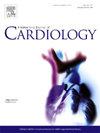STEMI患者初次PCI术后微血管灌注异常与定量血流比的相关性
IF 3.2
2区 医学
Q2 CARDIAC & CARDIOVASCULAR SYSTEMS
引用次数: 0
摘要
目的:及时评估微血管灌注异常(MVP)可改善st段抬高型心肌梗死(STEMI)患者的预后。本研究旨在确定对比血流定量流量比(cQFR)在评估STEMI患者首次经皮冠状动脉介入治疗(PPCI)成功后异常MVP和后续结局中的临床意义。方法:研究人群由2个独立队列组成。诊断队列用于评估cQFR在预测异常MVP中的相关性和诊断准确性。在该队列中,从前瞻性连续登记中评估罪魁祸首血管的MVP和cQFR (n = 186)。应用心肌对比灌注超声心动图(MCE)检测PPCI后元凶血管的MVP异常。预后队列由接受PPCI的STEMI患者组成,随访至少2 年(n = 1931)。主要结局为全因死亡率。结果:在诊断队列中,cQFR与MCE评估的异常MVP表现出中度相关性。ppci后cQFR预测异常MVP的特异性、敏感性和曲线下面积分别为81.6 %、50.9 %和0.709(95 %置信区间:0.635 ~ 0.783),最佳截断值为0.875。结论:我们发现cQFR在预测STEMI患者PPCI成功后异常MVP方面表现出相对较好的性能。cQFR值低于0.875是异常MVP和长期死亡率的独立预测因子。cQFR对STEMI患者预后的影响;NCT04996901)。本文章由计算机程序翻译,如有差异,请以英文原文为准。
Correlation between abnormal microvascular perfusion and quantitative flow ratio after primary PCI in patients with STEMI
Aims
Timely assessment of abnormal microvascular perfusion (MVP) may improve prognosis in patients with ST-segment elevation myocardial infarction (STEMI). This study aimed to determine the clinical implications of contrast-flow quantitative flow ratio (cQFR) in evaluating abnormal MVP and subsequent outcomes among STEMI patients after successful primary percutaneous coronary intervention (PPCI).
Methods
The study population consisted of 2 independent cohorts. The diagnostic cohort was used to evaluate the correlation and diagnostic accuracy of cQFR in predicting abnormal MVP. In this cohort, MVP and cQFR of the culprit vessel (n = 186) were assessed from a prospective consecutive registry. Abnormal MVP was determined using myocardial contrast perfusion echocardiography (MCE) in the culprit vessel after PPCI. The prognostic cohort consisted of STEMI patients undergoing PPCI who were followed for a minimum of 2 years (n = 1931). The primary outcome was all-cause mortality.
Results
In the diagnostic cohort, cQFR exhibited a moderate correlation with abnormal MVP assessed by MCE. Specificity, sensitivity, and area under the curve of post-PPCI cQFR to predict abnormal MVP were 81.6 %, 50.9 % and 0.709 (95 % confidence interval: 0.635–0.783), respectively, with the best cut-off value of 0.875. In the prognostic cohort, patients with cQFR <0.875 showed a significantly higher risk of long-term mortality compared to those with cQFR ≥0.875 (median follow-up: 52 months; mortality: 8.0 % vs. 3.8 %; p < 0.001). Cox-regression analysis revealed that cQFR < 0.875 was an independent predictor of long-term mortality (adjusted HR: 2.132; 95 % CI: 1.358–3.346; p = 0.001) after adjusting for age, gender, diabetes mellitus, hyperlipidemia, symptom to balloon time, culprit vessel.
Conclusions
We found that cQFR demonstrated a relatively good performance in predicting abnormal MVP in patients with STEMI after successful PPCI. A cQFR value below 0.875 is an independent predictor of both abnormal MVP and long-term mortality. (Prognostic implication of cQFR in STEMI patients; NCT04996901).
求助全文
通过发布文献求助,成功后即可免费获取论文全文。
去求助
来源期刊

International journal of cardiology
医学-心血管系统
CiteScore
6.80
自引率
5.70%
发文量
758
审稿时长
44 days
期刊介绍:
The International Journal of Cardiology is devoted to cardiology in the broadest sense. Both basic research and clinical papers can be submitted. The journal serves the interest of both practicing clinicians and researchers.
In addition to original papers, we are launching a range of new manuscript types, including Consensus and Position Papers, Systematic Reviews, Meta-analyses, and Short communications. Case reports are no longer acceptable. Controversial techniques, issues on health policy and social medicine are discussed and serve as useful tools for encouraging debate.
 求助内容:
求助内容: 应助结果提醒方式:
应助结果提醒方式:


